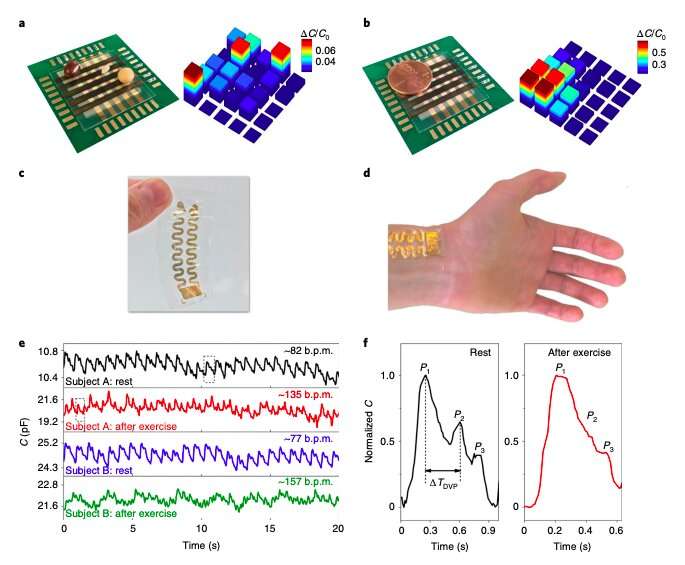February 20, 2020 feature
Highly sensitive pressure sensors for robotics and healthcare applications

Microscopic sensors that can detect small changes in pressure have numerous useful applications, particularly for the development of robots and health-monitoring wearable devices. Most existing capacitive and transistor-based pressure sensors, however, have a number of limitations, including low sensitivity, slow response speed, high power consumption and unsatisfactory stability.
Researchers at the University of California and Hunan University have recently proposed a new strategy for developing highly sensitive pressure sensors that could overcome some of the limitations of existing pressure sensors. Their approach, presented in a paper published in Nature Electronics, entails the integration of a conductive microstructured air-gap gate (CMAG) with 2-D semiconductor transistors.
"I've always been more interested in practical applications than theoretical research," Yun-Chiao Huang, one of the researchers who carried out the study, told TechXplore. "During my first year at UCLA, Prof. Duan encouraged me to explore different areas and find the topic that I was most passionate about. After reading many papers, I became interested in pressure sensing applications and started experiment with them."
Huang and her colleagues fabricated their pressure sensors by integrating CMAGs with 2-D semiconductor transistors, as they found that this design enhanced their sensing performance. This idea came to them during a group meeting in which Huang was presenting some of her research findings.
"We thought that if we could create 'real' microstructured air gaps to overcome the viscoelastic behavior of the elastomers from conventional microstructured devices and integrate them with 2-D transistors, our sensors would exhibit enhanced pressure sensitivity and faster responses," Huang said. "This would benefit a broad range of practical applications, such as acoustic wave detection, pressure mapping, health monitoring, and more."
In the sensors developed by the researchers, CMAGs create microstructured air gaps without resulting in undesirable viscoelastic behavior, which is observed in elastomers within more conventional devices. This ultimately leads to a higher sensitivity, faster response times, low power consumption and remarkable stability.
"By integrating 2-D semiconductor transistors with unique CMAGs, our CMAG transistor sensors can be further enhanced for better performance, enabling a wide range of applications," Huang said.
In initial experiments, the sensors built by the researchers exhibited a tunable sensitivity and pressure sensing range, with an average sensitivity of 44kPa-1 in the 0-5 kPa regime and a peak sensitivity of up to 770 kPa-1. In addition, when using the air-gap gates as pressure-sensitive gates for 2-D semiconductor transistors, Huang and her colleagues were able to further increase the sensitivity of their devices to ~103–107 kPa−1, at an optimized pressure regime of ~1.5 kPa.
The CMAG-based design strategy introduced by Huang and her colleagues is fairly easy to implement. In addition, it can be applied to the development of both capacitive and transistor-based sensors.
The researchers demonstrated the potential of their pressure sensors for a number of applications, including the implementation of static pressure mapping, the measurement of human pulse waves and the detection of sound waves. In the future, their highly sensitive sensors could be used to develop robots with more advanced sensing capabilities, wearable devices to monitor the health of patients over time, and several other technological tools.
"Hopefully, the concept of CMAGs will pave a way for new type of pressure sensors," Huang said. "We are now working on conformal/flexible pressure sensory arrays based on the concept of CMAGs, which will enable the human-machine interface and related applications. We are looking forward to showcasing more of our work in the future."
More information: Yun-Chiao Huang et al. Sensitive pressure sensors based on conductive microstructured air-gap gates and two-dimensional semiconductor transistors, Nature Electronics (2020). DOI: 10.1038/s41928-019-0356-5
© 2020 Science X Network


















